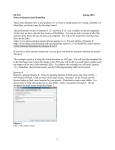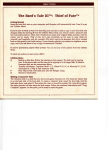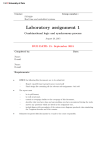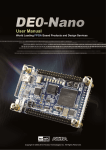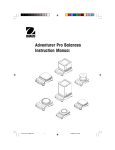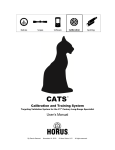Download novelcs-insert - Museum of Computer Adventure Game History
Transcript
INTRODUCTION
Welcome to the Computer Novel Construction Set! With this program, you will be
able to create your own exciting text adventures. The Computer Novel Construction
Set is a powerful, easy-to-use software package that will allow you to define your own
Objects, Rooms, Vocabulary, Timed Events and much, much, more!
Take the time now to read the TimeQuest™ Guide to Adventures and Adventuring.
This guide will give you some insight into the history of text adventures, as well as some
background knowledge which you will find useful when you begin creating your own
text adventures. While you are reading through the guide, remember, all of the features
outlined can be implemented with the Computer Novel Construction Set!
The Computer Novel Construction Set package contains the following items:
• A Program Disk with the following:
- Story Maker Program
- Story Player Program
- Sample Text Adventure
- Full-length Text Adventure
• A User Manual with the following:
- Introduction
- Playing A Story
- Making A Story
- Reference Section
- Examples
THE PROGRAM DISK
Story Maker:
The Story Maker is the heart of the Computer Novel Construction Set. This
powerful utility allows you to build new text adventures or further refine existing
ones.
Story Player:
The Story Player allows the story you have created to be played. Give a copy of
your game to your friends and let them experience your creations.
Sample Story:
This story, in conjunction with the Making A Story section of the User Manual,
will give you a guided tour through the creation of a story.
Full-length Text Adventure:
Entitled "Save The World", this exciting adventure was created by the designers
of the Computer Novel Construction Set. It is a challenging "James Bond" like
adventure, which illustrates the full range of features available in the Computer
Novel Construction Set.
1
THE USER MANUAL
Introduction:
This section introduces you to the Computer Novel Construction Set and gives
you information on how to use the program and manual most effectively.
Playing A Story:
This section will teach you the basic techniques needed to play a text adventure
created with the Computer Novel Construction Set.
Making A Story:
This section will show you how the Sample Adventure was constructed step-bystep. It will teach you the basic techniques needed to use the Story Maker by giving you detailed instructions on how to create your own story.
Reference Section:
The Reference section contains detailed information and will answer any questions you have about the program. Whether you are a first-time user or a
seasoned adventurer, the Reference section will expose you to the full power of
the Computer Novel Construction Set.
Examples:
This section illustrates how to incorporate some basic text adventure scenarios
into your stories. The section uses detailed examples which will help you to
understand some of the Computer Novel Construction Set's more powerful
features.
If you have not done so already, turn the page and read the TimeQuest™ Guide to
Adventures and Adventuring. We are sure that the information contained in the
following pages will stimulate your imagination and inspire you to create your own text
adventures.
2
TIMEQUEST™ GUIDE TO
ADVENTURES AND ADVENTURING
You are standing at the edge of a cliff. Thick fog hides what lies below, but the sound
of waves slapping against rocks is very distinct. The deep-throated baying and growling behind you is growing louder-the pack of wild dogs has caught up with you .
You edge toward the brink of the chasm, wondering if you could survive the fall. ..
What do you do now?
WHAT IS AN ADVENTURE?
If you are playing a computer adventure of the type that you can create with the Computer Novel Construction Set, what happens next in the scenario above would be up to
you. Computer adventure games are perhaps the most sophisticated form of singleplayer entertainment ever devised. Combining intellectual challenge with the lure of
wealth and the excitement of exotic surroundings, adventures are a unique partnership
between the author and the reader, one in which the player helps to create the story as
he progresses through it.
The original computer adventure was basically a romp through a series of caves in
which the player was required to solve logic puzzles in order to survive and find
treasures. As the capabilities of microcomputers expanded and programming techniques and languages became more sophisticated, adventures became more and more
complex. Modern adventures involve scores of locations and dozens of objects, along
with various characters and complicated interrelationships among the objects.
The basic premise of the adventure remains virtually the same, however. There is a
goal to be reached, and danger along the way. The computer acts as your guide,
describing the scenery and telling you what is happening. Using multi-word commands
(such as TAKE THE SWORD or READ THE OLD BOOK), you convey your desires to
the computer and it implements those commands. You can pick up and manipulate objects, interact with other characters, and move from place to place in the microworld
that is inhabited by your computer counterpart. The computer provides responses to
your actions as well, and changes objects and locations based on what you have done.
3
Achieving the ultimate goal of the adventure (which usually involves finding a
treasure of some sort) requires that you achieve many other minor goals. A typical
adventure might open with the ultimate goal of finding and recovering a priceless jewel
from the depths of a dungeon in a haunted castle. You begin the adventure outside a
castle, faced with the problem of getting into the building. Once inside, you are faced
with a variety of dangers-trap doors, murderous ghosts, and the like-as well as a
number of puzzles that must be solved before the treasure can be found . There may, for
instance, be a locked door leading to the dungeon, a door that will require a key to
open. Finding the key would become a major goal, but other, small goals must be
reached first. Let's say, for instance, that the key is in the possession of a ghost, who can
only be destroyed by water. This means that a container and water must be found. The
container is easy enough to find, but what about water? Maybe the water is in a well outside, but the outer door is locked, which means that you must now find a way to get
outside ...
You can imagine how challenging adventures can be!
Modern adventures afford the adventurer much more than simple exploration and
manipulation of objects, however. With today's adventures, you may sometimes get
clues from querying the computer (if the author of the adventure has included that
feature). You can even "develop" your character or other characters in the story, based
on how you, as a player, interact with other characters. Indeed, many adventures take
on the elements of print fiction, with true plots, character development, and more than
one way to solve problems.
As you become adept at using the Computer Novel Construction Set, you will be
able to include all of these features in your own adventures, and much more.
HOW AN ADVENTURE IS PLAYED
In a typical adventure, the documentation and on-screen text set the stage for your
story. This includes the setting, the situation that you will find yourself in, and in some
cases, what your goal will be.
Once you've loaded the adventure, you are presented with an initial scene description. (In adventuring, by the way, all locations are referred to as "rooms." Even if a
location is outside-in a meadow-it is still referred to as a "room.") This initial description should tell you what the room or area looks like, and the directions of any exits
(unless those are part of a puzzle to be worked out by the player). There should also be a
listing of the objects present, except when one object is inside another, or must be
searched out.
4
Let's assume that you are playing an adventure that opens with a scene something like
this:
~Office------------------------~
You are sitting at a desk in the office of a small shop . There are books and
papers scattered all over the desk . A doorway leads to the East .
You can see a flute here.
You can see a box of jewels here .
You can see a throwing knife here .
C'" '"m
flute
jewels
knife
HANDLING OBJECTS
At this point, you will want to look at or examine as many of the objects in the room as
possible.
In general, you can GET, TAKE, or PICK UP objects. Most can be EXAMINEd or
LOOKed at (this will usually get you a detailed description of the object). Books, notes
and signs can be READ, and boxes and doors can be OPENed. Buttons and levers can
be PUSHed or PULLed. Some objects can also be DROPPED or THROWN (although
throwing an object may have a different result from dropping it!). You can usually do
the obvious with special objects, such as playing a musical instrument, blowing a
whistle, turning on a radio, and the like. You may, of course, have to find another object
to make a special object work. For example, a radio could require batteries!
Once you have examined everything in the room and taken everything that is of
interest, you should think through the possible uses that the objects may have. Some
objects provide clues-the throwing knife, for example, should tip you off that there
may be something for you to throw the knife at. Unless, of course, the author of the
game put the knife in simply to mislead you . Some adventures include objects that have
no real use in solving puzzles, but which aid in creating a feeling of realism, and complicate matters by being misleading. Take care in picking things up, though-some
objects may be booby-trapped.
5
Think of how two objects might be put together, too; this could be important later on.
For instance, you may find a cartridge in one room, and later on find an object that has
a slot in which to insert the cartridge. In general, it is a good idea to try to do everything
you can with objects-especially when you are stuck in a particular location.
When trying to perform actions such as crawling through a small hole or opening a
stuck door, keep in mind the fact that some steps require that you have certain objects
present, or not present.
MOVEMENT
After exploring a room and the objects within, it's time to move around. In our
hypothetical adventure, you can move to the East only (or, can you? Perhaps if we
MOVED the DESK, we would find that it hides a secret passageway!) Moving East will
take you to another room, or perhaps outside or into a pit. It's up to the author to decide
where various directions lead, and it's up to the player to find out!
In general, you can move to any of the four main compass points (NORTH, SOUTH,
EAST, or WEST). In most adventures, the room descriptions assume that you are facing
NORTH at all times. Movement may also be accomplished by CLIMBing or JUMPing.
Climbing usually requires that you specify an object to climb, as in the command
CLIMB THE TREE, although you may also CLIMB DOWN, if the author permits it.
Jumping normally implies jumping down, as in jumping down from a ledge, but you
might also jump up to grab a rope, or jump across or over something.
You should also keep in mind the possibility that other movement-type verbs may
work in the adventure. SLIDE, RUN, SIT, STAND, and LAY are all verbs that can be
used to move from one place to another, although these verbs are usually used in conjunction with an object, as in SLIDE DOWN THE POLE .
MAPPING
Mapping is of utmost importance in adventuring. With as many as 100 rooms in some
adventures, it is difficult if not impossible for the adventurer to keep track of all the locations and how to move from one room to another. Also, a map provides a handy way to
record the location of items of interest or danger.
You should lay out your map on a large piece of paper. Don't make your notations too
large-you never know which way the map will run. Begin with the first room, and use
standard compass notation (i.e., North will be the direction to the top of the page). Use
squares, circles, triangles-whatever shapes you find pleasing. Or, you may wish to use
different shapes for different types of rooms. Leave enough room to note items of
interest, and show the directions of any exits.
6
STRATEGIES
In a well-written adventure (meaning one that is logically laid out, and is consistent in
its rules), your best strategy is to observe everything and try anything that is obvious.
Keep your mind open-quite a bit of mythology pops up in adventures. If, for instance,
you are standing in front of a massive door that won't open, try saying "OPEN
SESAME." If you find an old lamp, rub it.
Pay close attention to room descriptions and to any changes that come about as a
result of your actions, or time passing. Watch the wording of the text; this can
sometimes provide clues, in the manner of riddles. If an adventure has a feature that
displays accumulated points, or which allows you to ask to see the accumulated points,
check point values frequently, especially before and after you get or manipulate
objects. If you get points for picking up or doing something with a certain object, this
can be a clue.
Save your game frequently! If you think that moving into a certain room or taking a
particular action is going to be fatal, save your game. This will avoid your having to go
back through the adventure from the beginning.
7
HOW AN ADVENTURE IS WRITTEN
If you've played an adventure, you've no doubt been amazed at the depth and range
of experiences available, as well as the realism present. You should be aware, however,
that all of this is an illusion, created by the author's text and the computer program's
"magic."
USING THE COMPUTER NOVEL CONSTRUCTION SET
In using the Computer Novel Construction Set, you will find that the program,
parser, and data base are already operating for you. All you have to do is tell the system
which words it should understand, how to react to certain verb-noun combinations
(commands), what text will be used, how to interconnect rooms, and how to deal with
such "extras" as timed events, scoring, the beginning of the game, and the end of the
game. The Computer Novel Construction Set keeps track of which objects you are carrying, objects which are present in each room, when to display text, and other features
that maintain the illusion of the story.
In creating your own adventure, however, you will have to go through the same
creative process as anyone who creates an adventure or writes a novel. You will find that
this is something of an evolutionary process-that is, your adventure will grow of its own
accord and, in some instances, even write parts of itself as you develop it.
PLANNING YOUR STORY
The first step in creating your adventure is to determine just what type of story you
wish to write-fantasy, modern adventure, science fiction, mystery, romance, or
whatever. With this established, your next move will be to create the story line, which is
basically a chronicling of the major events in the story, as well as determining what the
major goal will be.
Rooms
I
I
I
ROOM NAME :
ROOM DESCRIPTION:
OBJECT:
OBJECT :
II OBJECT:
II OBJECT:
8
kitchen
family room
front yard
corner stor•
sidewalk
Mars
Next, plan your locations. If you are writing a science fiction adventure, you will probably have an alien world or two, and a spacecraft. For a western, your setting might be
a small town. Begin by describing the opening scene, and then moving to the final
scene.
After this, determine just what locations are required by your story . A western story,
for example, might begin in a saloon, and end in the middle of a deserted street. In between, there may be a card game, a train or bank robbery and a gun fight. These events
require different locations . For example, a smoke filled room is required for the card
game, and a bank is required for the robbery. Once you have established these locations, others will be implied, such as a street which connects the bank and the saloon .
Mapping
Once you have listed your major locations, you can begin mapping your adventure.
Begin with the opening location, and interconnect all locations in a logical manner. Do
this on paper, initially. As your adventure setting grows, new locations will suggest
themselves. For instance, a spaceship control room may imply an engine room.
Objects
With the basic mapping done, you will need to decide what objects are necessary.
This can be determined in part by the story line. If you are writing a fantasy quest
adventure, it is almost axiomatic that there will be certain valuable treasures such as
jewels or rings to find. A jungle adventure will most likely require that your hero have a
rifle and perhaps a bush knife .
The major story events will also have a bearing on the objects required. If you are
writing a science fiction story, and one of the locations is a spacecraft, it is more than
likely that there will be a spacesuit present. The western story described earlier could
require a gun and deck of cards. Locations will suggest objects, as well. Depending
upon how detailed and realistic you want to make your adventure, you could include all
manner of objects for the player to work with. A department store location could be
filled with items-most of them useless to the plot-that the player can pick up or buy .
The armory of a medieval castle might offer swords, knives, and all manner of exotic
weaponry. Again, how many objects are present depends upon what level of detail you
wish to include.
There are some objects which may suggest themselves as "red herrings" -that is,
objects which seem valuable, but which offer no real aid to the adventurer. For
example, you might include an empty chest, which the adventurer will assume is
required to haul some object, but which, in reality, will be used for nothing. This type of
element makes for a feeling of uncertainty in your adventure, just like real life!
9
Problems and Plotting
After working out your story line, locations and objects, it is time to start setting up
obstacles. These are the logic problems and puzzles that adventures are so famous for.
Some problems will be direct, simple obstacles, like the need to find a key to open a
door. Others will be tricky challenges, involving not only the player's knowledge of
your adventure "universe", but also his knowledge of general or special topics. Adventurers have been known to consult encyclopedias in search of solutions to puzzles. A
typical adventure logic puzzle might involve a series of color-coded buttons which need
to be pushed in a certain order. The clue to solving this may be in another part of the
adventure, but disguised in such a manner as to avoid easy discovery. Perhaps the
player sees a series of colored doors as he walks down a hallway, and the sequence of
these doors hints at the button-pushing sequence.
Add a little spice to some of the problems by making the wrong solution a fatal one
(or, at the very least, one which results in the player losing the game). In the buttonpushing example just given, the wrong sequence might set off a bomb.
Complicate problems whenever possible-adventurers love complex problems. If the
player needs to get a key to open a door, put some obstacles between the player and the
key (the ghost, bucket and water problem sequence discussed earlier is an excellent
example of a problem complication.) Or, add a double-whammy by putting in two
keys-one that is easy to find (the wrong one), and one that carries its own
complications.
You will be surprised to find just how much these story elements will interact. Your
story line, objects, locations, and problems in the story will begin to affect one another
very early on, and changes in one element will almost always "feed back" to other
elements. The result of that is that, as you work on your adventure, new locations,
objects, problems, and solutions will suggest themselves. Like most works of art, a piece
of interactive fiction is very flexible and self-perpetuating.
Descriptions
As your adventure develops, you should be making notes about what is in each room,
as well as the room's general appearance . You will also want to develop one-line
descriptions for objects that you will allow the player to examine. These will be the
LOOK descriptions that you specify in the Computer Novel Construction Set Story
Maker program .
Room descriptions should give the player an immediate feel for the location-that is,
let the player know right away if he is outside or inside, and the general type of location
he is in (kitchen, meadow, etc.). Next, list objects present, along with any important
details such as exits, unusual features (great for giving clues), and the like.
10
Each object name should give the reader a good mental image of the object (usually,
just a single noun, such as "Flashlight" or "Rifle", is enough). Use detail in LOOK
DESCRIPTIONS to provide clues ("The end of the rod has a socket in it.") or to explain
unusual detail ("This is an antique jewelry case, with a secret compartment in the
bottom.").
When writing descriptions, strive to use the most specific image-producing nouns
and verbs possible. For instance, use "German Shepherd" instead of just "Dog", and
"Sauntered" or "Strolled", rather than "Walked slowly."
EXTRA FEATURES
If you wish to add polish to your adventure, don't leave out Timed Events. The
Computer Novel Construction Set offers you two ways to handle these. You can
establish limits in your adventure by placing a time limit on how long a player has to
solve a puzzle or reach a goal. You can also add suspense by having Timed Events
touched off by a player action-the player might pick up a bomb for disposal, and have
only so much time or so many moves before it explodes.
NAME OF TIMED EVENT :
\or'H AT TRIGGERS TIMED EVENT?
PLAYER LOCATION:
REQUIRED ST ATE :
REQUIRED OBJECT :
PROB ABILITY :
TIMED EVENT ST ARTS :
\or'H AT DOES THE TIMED EVENT DO?
STATE SET:
MESS AGE PRINTED:
EFFECT ON OBJECT :
SECOND OBJECT:
NEW LOCATION :
*
TI MEO EVENTS
*
NAME
PLAYER LOCATION
REQUIRED STATE
REQUIRED OBJECT
PROBABILITY
DELAY
STATE SET
MESSAGE PRINTED
EFFECT ON OBJECT
SECOND OBJECT
NEW LOCATION
Allowing the player to interact with other characters is an excellent way to add
interest and heighten realism. Interaction may be as simple as a character responding
favorably when the player bows to him, or as complex as the character asking questions. It is also possible to establish variable states in which a character will refuse to
help the player if the player was not courteous to that character earlier in the game.
In the end, you are limited only by your imagination. The Computer Novel Construction Set will enable you to do almost anything you wish in the microworld of your
adventure.
11
Hayden Software Company, 600 Suffolk Stre~t, Lowell, MA 01854
32900-00


















